Palm Sunday: Jesus’ and our Gethsemane

ARTISTIC TRADITION Kim Xymon Bautista, 7, of Famy, Laguna province, helps his family in the weaving of palm fronds that will sell for P15 apiece outside Sto. Domingo Church in Quezon City, for the celebration of Palm Sunday today, the beginning of Holy Week. The palm frond is a symbol of victory and peace. RAFFY LERMA
Palm Sunday marks the beginning of Holy Week, also called Passion Week, the most solemn and intense period of worship in the Christian world. This culminates in the celebration of Christ’s resurrection on Easter Sunday, the cornerstone of the Christian faith.
The Gospel of the Passion of Christ (Mark 14:1-15:47) is read in today’s Mass. (It is reread the second time on Good Friday.) It tells the story of Jesus’ last supper with his disciples, the agony of Jesus in the Garden of Gethsemane, the betrayal of Judas and the arrest, trial, crucifixion, death and burial of Jesus.
Tying the three other readings in today’s Mass, we find the common themes of suffering and obedience.
The first reading (Isaiah 50:4-7) is about the submissiveness of the suffering servant to his persecutors. The psalm (Psalm 22) is a prayer of a man of God suffering from persecution. The second reading (Philippians 2:6-11) is about the suffering of Christ in humble obedience.
Suffering in Gethsemane
Article continues after this advertisementReflecting on these themes, we can contemplate on the story of Jesus praying at the Garden of Gethsemane (Mark 14:32-42). Gethsemane is the garden where Jesus and his disciples went after having supper on the eve of Jesus’ crucifixion. Located at the foot of the Mount of Olives, it is known as the place where Jesus agonized and prayed while his disciples slept.
Article continues after this advertisementThe brief passage is rich in intertextual echoes of the Hebrew Scriptures as it continues the pervasive motif in the preceding verses, in which Jesus predicts that Peter would deny knowledge of him and his suffering and abandonment by his followers during a time of trial (Job 19:13-22; Psalm 41:8-10; 55:12-14; Zechariah 13:5-7).
In the account, Jesus told Peter, James and John: “My soul is sorrowful even to death.” These words of Jesus reflect Psalms 42:5, 11; 43:5, “My soul is cast down within me.” Jesus is the innocent sufferer who speaks in the language of the lament psalms (see also Psalms 31:10-11;55:5).